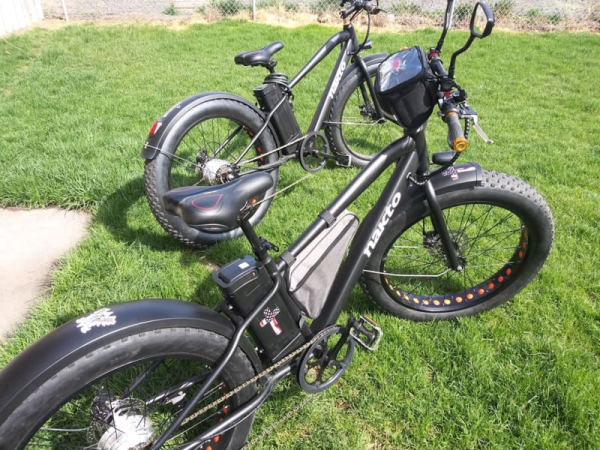Electric bike, commonly known as e-bike. These bikes are becoming increasingly popular for their efficiency, environmental friendliness, and ability to enhance mobility.
Whether it’s commuting, leisure or fitness, there’s an e-bike for every type of rider. In this article, we’ll explore the various categories of e-bikes and identify the fastest models to help you make the best choice!
Types of Electric Bikes

There are many types of electric bicycles designed to meet different terrains such as slopes, roads, etc. The most common types of e-bikes include mountain bikes, folding bike, city bikes, fat bikes and kids' bikes. Each type has its own characteristics, and you can identify them through the following information:
Mountain Electric Bike
Mountain e-bikes or electric mountain bikes (e-MTBs) are equipped with features such as a sturdy suspension system, durable tires, and a powerful motor to provide extra torque for climbing steep trails. Electric mountain bikes are perfect for adventurers exploring rugged landscapes.
Folding Electric Bike
Folding e-bikes can easily fold down into a more manageable size, making them ideal for urban commuters who may need to carry their bike on public transport or store it in tight spaces. Typically, folding ebike battery can be fully charged in just 4 to 6 hours, providing a convenient and effective mode of transportation.
urban electric bike
Urban e-bikes are a great choice for daily commuting, and they often feature a more comfortable, upright riding position, practical accessories like luggage racks and fenders, and smooth, quiet motors.
Fat Tire Electric Bike
Fat tire e-bikes feature large, wide tires that provide excellent traction and stability, which makes them ideal for riding on difficult terrain such as sand, snow, or mud. They're also popular among those who prioritize riding comfort, as the large tires provide natural cushioning over bumps and dips.
Kid's Electric Bicycle
Kid's e-bikes often have lower power settings and safety features to help parents maintain control of the bike's speed and use. They are a great way to introduce children to cycling, providing them with a sense of independence while keeping them safe.
These different categories of e-bikes ensure there is a suitable option for every type of rider, and understanding each type of bike can help riders make the best choice.
What are the different categories of e-bikes?

Electric bicycles can be divided into three main levels based on power-assisted mode and speed: Class 1, Class 2 and Class 3.
Class 1 e-bikes: Class 1 e-bikes offer pedal assist but no manual throttle. The motor of this type of e-bike only activates when the rider pedals, and the top speed is limited to 20 mph (about 32 km/h).
Class 2 electric bicycles: In addition to providing pedal assistance, Class 2 electric bicycles are also equipped with a manual throttle, allowing the rider to start the motor even without pedaling. The top speed of these bikes is also limited to 20 mph.
Class 3 electric bicycles: Class 3 electric bicycles provide stronger pedal assistance and can reach a top speed of 28 mph (about 45 km/h), but do not provide a manual throttle.
What is the fastest electric bike?
Not all e-bikes are created equal when it comes to speed. The title of fastest e-bike changes frequently as new technology and innovations emerge.
However, with models like the stealth B-52 bomber, which has a top speed of up to 50 miles per hour, these bikes utilize powerful motors and often focus on performance rather than pedal assist.
What type of bicycle is suitable for women to ride?
In order to choose the right e-bike for women, it’s often helpful to consider a few key factors: design, weight, height, comfort, and purpose. Here are a few types of electric bikes that may be more suitable for women:
Step-Through Frame: step thru ebike have a lower top tube, making it easier to get on and off the bike, especially when the rider is wearing a skirt or dress.
Urban E-Bikes: Urban E-Bikes are usually designed with comfortable cushions and an upright riding position, which helps reduce waist and back pressure.
Folding E-Bikes: This type of bike is ideal for women who live in apartments or in situations where space is limited. Folding bikes can be easily taken on public transportation or stored in smaller spaces in offices and homes.
Comfort E-Bikes: Comfort E-Bikes pay special attention to riding comfort and are usually equipped with widened seat cushions and adjustable handlebars. The design of these bicycles may also include shock-absorbing devices to aid riding comfort. Riders find the most comfortable riding position.
Summarize
All in all, e-bikes include city, fat-tire and kid's models, ranging from rugged mountain bikes designed for rough terrain to foldable e-bikes for urban commuters to suit different lifestyles. By understanding the types of electric bikes in this article, I believe you can choose a bike that is best for you.
Of course, if you want to be a distributor, you can wholesale electric bikes at Nakto, and they will provide you with a 2-year warranty for your purchase.
Whether it’s commuting, leisure or fitness, there’s an e-bike for every type of rider. In this article, we’ll explore the various categories of e-bikes and identify the fastest models to help you make the best choice!
Types of Electric Bikes

There are many types of electric bicycles designed to meet different terrains such as slopes, roads, etc. The most common types of e-bikes include mountain bikes, folding bike, city bikes, fat bikes and kids' bikes. Each type has its own characteristics, and you can identify them through the following information:
Mountain Electric Bike
Mountain e-bikes or electric mountain bikes (e-MTBs) are equipped with features such as a sturdy suspension system, durable tires, and a powerful motor to provide extra torque for climbing steep trails. Electric mountain bikes are perfect for adventurers exploring rugged landscapes.
Folding Electric Bike
Folding e-bikes can easily fold down into a more manageable size, making them ideal for urban commuters who may need to carry their bike on public transport or store it in tight spaces. Typically, folding ebike battery can be fully charged in just 4 to 6 hours, providing a convenient and effective mode of transportation.
urban electric bike
Urban e-bikes are a great choice for daily commuting, and they often feature a more comfortable, upright riding position, practical accessories like luggage racks and fenders, and smooth, quiet motors.
Fat Tire Electric Bike
Fat tire e-bikes feature large, wide tires that provide excellent traction and stability, which makes them ideal for riding on difficult terrain such as sand, snow, or mud. They're also popular among those who prioritize riding comfort, as the large tires provide natural cushioning over bumps and dips.
Kid's Electric Bicycle
Kid's e-bikes often have lower power settings and safety features to help parents maintain control of the bike's speed and use. They are a great way to introduce children to cycling, providing them with a sense of independence while keeping them safe.
These different categories of e-bikes ensure there is a suitable option for every type of rider, and understanding each type of bike can help riders make the best choice.
What are the different categories of e-bikes?

Electric bicycles can be divided into three main levels based on power-assisted mode and speed: Class 1, Class 2 and Class 3.
Class 1 e-bikes: Class 1 e-bikes offer pedal assist but no manual throttle. The motor of this type of e-bike only activates when the rider pedals, and the top speed is limited to 20 mph (about 32 km/h).
Class 2 electric bicycles: In addition to providing pedal assistance, Class 2 electric bicycles are also equipped with a manual throttle, allowing the rider to start the motor even without pedaling. The top speed of these bikes is also limited to 20 mph.
Class 3 electric bicycles: Class 3 electric bicycles provide stronger pedal assistance and can reach a top speed of 28 mph (about 45 km/h), but do not provide a manual throttle.
What is the fastest electric bike?
Not all e-bikes are created equal when it comes to speed. The title of fastest e-bike changes frequently as new technology and innovations emerge.
However, with models like the stealth B-52 bomber, which has a top speed of up to 50 miles per hour, these bikes utilize powerful motors and often focus on performance rather than pedal assist.
What type of bicycle is suitable for women to ride?
In order to choose the right e-bike for women, it’s often helpful to consider a few key factors: design, weight, height, comfort, and purpose. Here are a few types of electric bikes that may be more suitable for women:
Step-Through Frame: step thru ebike have a lower top tube, making it easier to get on and off the bike, especially when the rider is wearing a skirt or dress.
Urban E-Bikes: Urban E-Bikes are usually designed with comfortable cushions and an upright riding position, which helps reduce waist and back pressure.
Folding E-Bikes: This type of bike is ideal for women who live in apartments or in situations where space is limited. Folding bikes can be easily taken on public transportation or stored in smaller spaces in offices and homes.
Comfort E-Bikes: Comfort E-Bikes pay special attention to riding comfort and are usually equipped with widened seat cushions and adjustable handlebars. The design of these bicycles may also include shock-absorbing devices to aid riding comfort. Riders find the most comfortable riding position.
Summarize
All in all, e-bikes include city, fat-tire and kid's models, ranging from rugged mountain bikes designed for rough terrain to foldable e-bikes for urban commuters to suit different lifestyles. By understanding the types of electric bikes in this article, I believe you can choose a bike that is best for you.
Of course, if you want to be a distributor, you can wholesale electric bikes at Nakto, and they will provide you with a 2-year warranty for your purchase.
Comments
Post a Comment